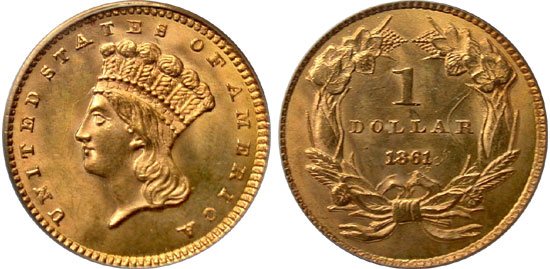Indian Pricess Gold Dollar
Source: My Coin Guides: The Indian Princess Gold Dollar was struck from 1854 to 1889 and represented the second series for the gold dollar denomination. The series was produced in two distinctive types, the first carried a smaller portrait and higher relief, while the second carried a larger portrait and lower relief. The coins were struck at five different mint facilities including Philadelphia, Dahlonega, Charlotte, New Orleans, and San Francisco, although production would take place almost exclusively at the Philadelphia Mint after the start of the Civil War. During the course of the series, there were a number of issues with extremely low mintages that have come to be recognized as great rarities.

The gold dollar denomination had been authorized under the Act of March 3, 1849 as a direct result of the California Gold Rush. The initial series was struck for five years and in relatively large numbers, but there were concerns that the coins were too small to be conveniently used in commerce. One potential solution was to place a hole in the middle of the coins in order to increase the diameter while staying within the limits of the gold content. This idea had also been suggested in the late 1840s, but at the time was not considered to be practical, and producing the planchets with holes required a cumbersome and costly process.
A solution was found in 1854 which was quite simple. An increase in diameter could also be accomplished by reducing the thickness of the coins. This was done, increasing the diameter from 13 to 15 millimeters, with new designs created in the process. The chief engraver of the Mint James Barton Longacre created the new obverse and reverse design. A so-called Indian Head, representing Liberty as a female Native American, appeared on the obverse with the inscription “UNITED STATES OF AMERICA” around. The reverse featured an agricultural wreath, composed of corn, cotton, tobacco, and wheat. The denomination “1 Dollar” and date appeared within the wreath.
There are many rare dates within the series, coming from the Charlotte and Dahlonega Mints prior to 1861, and various low-mintage issues in the 1870s and 1880s from the Philadelphia Mint. Proofs were struck throughout the series and range from extremely rare for some of the dates in the 1850s and 1860s to somewhat obtainable in the 1880s. A full set of Indian Princess Gold Dollars is extremely difficult to complete, although not impossible. A set of Proofs is more difficult to complete, thanks to the rarity of some of the early issues, but most dates in the 1870s and 1880s can be found with intensive searching and well-filled pockets.
